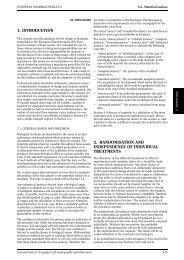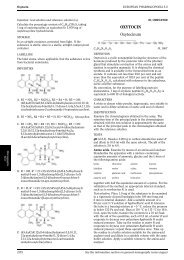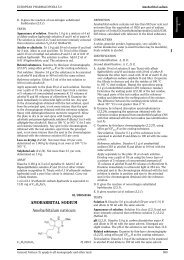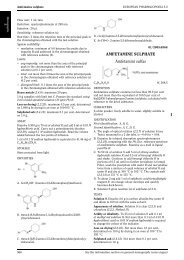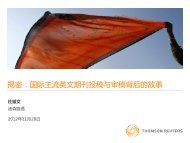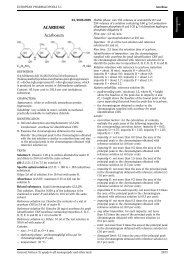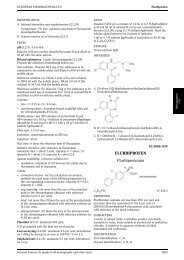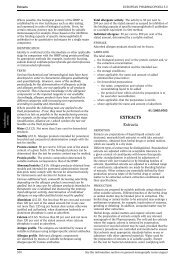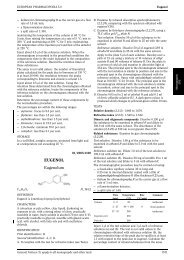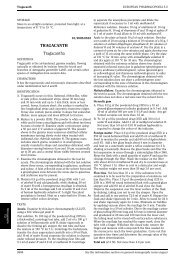BENPERIDOL Benperidolum
BENPERIDOL Benperidolum
BENPERIDOL Benperidolum
You also want an ePaper? Increase the reach of your titles
YUMPU automatically turns print PDFs into web optimized ePapers that Google loves.
EUROPEAN PHARMACOPOEIA 5.0 Benperidol<br />
Related substances, other than impurity B. Liquid<br />
chromatography (2.2.29).<br />
Test solution. Dissolve60.0mgofthesubstancetobe<br />
examined in 50 ml of acetonitrile R and dilute to 100.0 ml<br />
with water R.<br />
Reference solution (a). Dissolve 60.0 mg of benfluorex<br />
hydrochloride for system suitability CRS in 50 ml of<br />
acetonitrile R and dilute to 100.0 ml with water R.<br />
Reference solution (b). Dilute1.0mlofthetestsolutionto<br />
100.0 ml with a mixture of equal volumes of acetonitrile R<br />
and water R. Dilute 5.0 ml of this solution to 50.0 ml with<br />
thesamemixtureofsolvents.<br />
Column:<br />
— size: l =0.15m,Ø=4.6mm,<br />
— stationary phase: silica gel bonded with alkylamide<br />
groups (5 µm),<br />
— temperature: 60°C.<br />
Mobile phase: a mixture of equal volumes of acetonitrile R<br />
and a solution containing 2.18 g/l of potassium dihydrogen<br />
phosphate R adjusted to pH 2.5 with phosphoric acid R and<br />
6.5 g/l of sodium decyl sulphate R.<br />
Flow rate: 1.4ml/min.<br />
Detection: spectrophotometer at 210 nm.<br />
Injection: 10µl.<br />
Run time: 3 times the retention time of benfluorex.<br />
Relative retention with reference to benfluorex (retention<br />
time=about5min):impurityA=about0.9.<br />
System suitability:<br />
— signal-to-noise ratio: minimum 20 for the principal peak<br />
in the chromatogram obtained with reference solution (b),<br />
— peak-to-valley ratio: minimum 2.5, where Hp =height<br />
above the baseline of the peak due to impurity A, and<br />
Hv = height above the baseline of the lowest point of<br />
the curve separating this peak from the peak due to<br />
benfluorex in the chromatogram obtained with reference<br />
solution (a).<br />
Limits:<br />
— any impurity: not more than the area of the principal<br />
peak in the chromatogram obtained with reference<br />
solution (b) (0.1 per cent),<br />
— total: not more than twice the area of the principal peak<br />
in the chromatogram obtained with reference solution (b)<br />
(0.2 per cent),<br />
— disregard limit: 0.5 times the area of the principal peak<br />
in the chromatogram obtained with reference solution (b)<br />
(0.05 per cent).<br />
Heavy metals (2.4.8): maximum 20 ppm.<br />
1.0 g complies with limit test C. Prepare the standard using<br />
2mloflead standard solution (10 ppm Pb) R.<br />
Loss on drying (2.2.32): maximum 0.5 per cent, determined<br />
on 1.000 g by drying in an oven at 100-105 °C.<br />
Sulphated ash (2.4.14): maximum 0.1 per cent, determined<br />
on 1.0 g.<br />
ASSAY<br />
In order to avoid overheating in the reaction medium, mix<br />
thoroughly throughout and stop the titration immediately<br />
after the end-point has been reached.<br />
Dissolve 0.250 g rapidly in 2.0 ml of anhydrous formic<br />
acid R and add 50.0 ml of acetic anhydride R. Titrate<br />
immediately with 0.1 M perchloric acid, determiningthe<br />
end-point potentiometrically (2.2.20).<br />
1mlof0.1 M perchloric acid is equivalent to 38.78 mg of<br />
C19H21ClF3NO2. IMPURITIES<br />
A. R = CF3,R′ = H: 2-[[(1RS)-1-methyl-2-[2-<br />
(trifluoromethyl)phenyl]ethyl]amino]ethyl benzoate,<br />
B. R = H, R′ =CF3: 2-[[(1RS)-1-methyl-2-[4-<br />
(trifluoromethyl)phenyl]ethyl]amino]ethyl benzoate,<br />
C. benzoic acid,<br />
D. R = CH2-CH2-OH, R′ = H: 2-[[(1RS)-1-methyl-2-[3-<br />
(trifluoromethyl)phenyl]ethyl]amino]ethanol,<br />
E. R = CH2-CH2-OH, R′ =CO-C6H5: N-(2-hydroxyethyl)-N-[(1RS)-1-methyl-2-[3-(trifluoromethyl)phenyl]ethyl]benzamide,<br />
F. R = CH2-CH2-O-CO-C6H5,R′ =CO-C6H5:2-[benzoyl[(1RS)- 1-methyl-2-[3-(trifluoromethyl)phenyl]ethyl]amino]ethyl<br />
benzoate.<br />
<strong>BENPERIDOL</strong><br />
<strong>Benperidolum</strong><br />
01/2005:1172<br />
C22H24FN3O2 Mr 381.4<br />
DEFINITION<br />
Benperidol contains not less than 99.0 per cent and<br />
not more than the equivalent of 101.0 per cent of<br />
1-[1-[4-(4-fluorophenyl)-4-oxobutyl]piperidin-4-yl]-1,3-dihydro-<br />
2H-benzimidazol-2-one, calculated with reference to the<br />
dried substance.<br />
CHARACTERS<br />
A white or almost white powder, practically insoluble in<br />
water, freely soluble in dimethylformamide, soluble in<br />
methylene chloride, slightly soluble in alcohol.<br />
It shows polymorphism.<br />
IDENTIFICATION<br />
First identification: A.<br />
Second identification: B, C, D.<br />
A. Examine by infrared absorption spectrophotometry<br />
(2.2.24), comparing with the spectrum obtained with<br />
benperidol CRS. Examine the substances prepared as<br />
discs. If the spectra obtained in the solid state show<br />
differences, dissolve the substance to be examined and the<br />
GeneralNotices(1)applytoallmonographsandothertexts 1065
Benperidol EUROPEAN PHARMACOPOEIA 5.0<br />
reference substance separately in the minimum volume<br />
of methyl isobutyl ketone R, evaporate to dryness and<br />
record new spectra using the residues.<br />
B. Examine by thin-layer chromatography (2.2.27), using<br />
as the coating substance a suitable silica gel with a<br />
fluorescent indicator having an optimal intensity at<br />
254 nm.<br />
Test solution. Dissolve 30 mg of the substance to be<br />
examined in a mixture of 1 volume of acetone R and<br />
9 volumes of methanol R and dilute to 10 ml with the<br />
same mixture of solvents.<br />
Reference solution (a). Dissolve 30 mg of benperidol CRS<br />
in a mixture of 1 volume of acetone R and 9 volumes of<br />
methanol R and dilute to 10 ml with the same mixture<br />
of solvents.<br />
Reference solution (b). Dissolve 30 mg of benperidol CRS<br />
and 30 mg of droperidol CRS in a mixture of 1 volume<br />
of acetone R and 9 volumes of methanol R and dilute to<br />
10mlwiththesamemixtureofsolvents.<br />
Apply to the plate 10 µl of each solution. Develop over a<br />
path of 15 cm using a mixture of 1 volume of acetone R<br />
and 9 volumes of methanol R. Allow the plate to dry in air<br />
and examine in ultraviolet light at 254 nm. The principal<br />
spot in the chromatogram obtained with the test solution<br />
is similar in position and size to the principal spot in the<br />
chromatogram obtained with reference solution (a). The<br />
test is not valid unless the chromatogram obtained with<br />
reference solution (b) shows two clearly separated spots.<br />
C. Dissolve about 10 mg in 5 ml of ethanol R. Add0.5mlof<br />
dinitrobenzene solution R and 0.5 ml of 2Malcoholic<br />
potassium hydroxide R. A violet colour is produced<br />
which becomes brownish-red after 20 min.<br />
D.Mixabout5mgwith45mgofheavy magnesium oxide R<br />
and ignite in a crucible until an almost white residue is<br />
obtained (usually less than 5 min). Allow to cool, add 1 ml<br />
of water R, 0.05mlofphenolphthalein solution R1 and<br />
about 1 ml of dilute hydrochloric acid R to render the<br />
solution colourless. Filter. To a freshly prepared mixture<br />
of 0.1 ml of alizarin S solution R and 0.1 ml of zirconyl<br />
nitrate solution R, add1.0mlofthefiltrate.Mix,allowto<br />
stand for 5 min and compare the colour of the solution<br />
with that of a blank prepared in the same manner. The<br />
test solution is yellow and the blank is red.<br />
TESTS<br />
Related substances. Examine by liquid chromatography<br />
(2.2.29). Prepare the solutions immediately before use.<br />
Test solution. Dissolve 0.10 g of the substance to be<br />
examined in dimethylformamide R and dilute to 10.0 ml<br />
withthesamesolvent.<br />
Reference solution (a). Dissolve 2.5 mg of benperidol CRS<br />
and 2.5 mg of droperidol CRS in dimethylformamide R and<br />
dilute to 100.0 ml with the same solvent.<br />
Reference solution (b). Dilute 1.0 ml of the test solution to<br />
100.0 ml with dimethylformamide R. Dilute 5.0 ml of this<br />
solution to 20.0 ml with dimethylformamide R.<br />
The chromatographic procedure may be carried out using:<br />
— a stainless steel column 0.1 m long and 4.6 mm in internal<br />
diameter packed with base-deactivated octadecylsilyl<br />
silica gel for chromatography R (3 µm),<br />
— as mobile phase at a flow rate of 1.5 ml/min:<br />
Mobile phase A.A10g/lsolutionoftetrabutylammonium<br />
hydrogen sulphate R,<br />
Mobile phase B. Acetonitrile R,<br />
Time<br />
(min)<br />
Mobile phase A<br />
(per cent V/V)<br />
Mobile phase B<br />
(per cent V/V)<br />
Comment<br />
0-15 100→60 0 → 40 linear gradient<br />
15 - 20 60 40 isocratic elution<br />
20 - 25 100 0 switch to initial eluent<br />
composition<br />
25=0 100 0 restart gradient<br />
— as detector a spectrophotometer set at 275 nm.<br />
Equilibrate the column for at least 30 min with acetonitrile R<br />
and then equilibrate with the initial eluent composition for<br />
at least 5 min.<br />
Adjust the sensitivity of the system so that the height of the<br />
principal peak in the chromatogram obtained with 10 µl of<br />
reference solution (b) is at least 50 per cent of the full scale<br />
of the recorder.<br />
Inject 10 µl of reference solution (a). When the chromatogram<br />
is recorded in the prescribed conditions, the retention times<br />
are: benperidol about 6.5 min and droperidol about 7 min.<br />
The test is not valid unless the resolution between the peaks<br />
corresponding to benperidol and droperidol is at least 2.0.<br />
If necessary, adjust the concentration of acetonitrile in the<br />
mobile phase or adjust the time programme for the linear<br />
gradient.<br />
Inject 10 µl of dimethylformamide R as a blank, 10 µl of<br />
the test solution and 10 µl of reference solution (b). In the<br />
chromatogram obtained with the test solution: the area<br />
of any peak, apart from the principal peak, is not greater<br />
than the area of the principal peak in the chromatogram<br />
obtained with reference solution (b) (0.25 per cent); the<br />
sum of the areas of all the peaks, apart from the principal<br />
peak, is not greater than twice the area of the principal peak<br />
in the chromatogram obtained with reference solution (b)<br />
(0.5 per cent). Disregard any peak obtained with the blank<br />
and any peak with an area less than 0.2 times the area of the<br />
principal peak in the chromatogram obtained with reference<br />
solution (b).<br />
Loss on drying (2.2.32). Not more than 0.5 per cent,<br />
determinedon1.000gbydryinginanovenat100°Cto<br />
105 °C.<br />
Sulphated ash (2.4.14). Not more than 0.1 per cent,<br />
determined on 1.0 g in a platinum crucible.<br />
ASSAY<br />
Dissolve 0.300 g in 50 ml of a mixture of 1 volume of<br />
anhydrous acetic acid R and 7 volumes of methyl ethyl<br />
ketone R and titrate with 0.1 M perchloric acid,using0.2ml<br />
of naphtholbenzein solution R as indicator.<br />
1mlof0.1 M perchloric acid is equivalent to 38.14 mg of<br />
C 22H 24FN 3O 2.<br />
STORAGE<br />
Store protected from light.<br />
IMPURITIES<br />
A. 1-(piperidin-4-yl)-1,3-dihydro-2H-benzimidazol-2-one,<br />
1066 See the information section on general monographs (cover pages)
EUROPEAN PHARMACOPOEIA 5.0 Benserazide hydrochloride<br />
B. 1-[1-[4-(2-fluorophenyl)-4-oxobutyl]piperidin-4-yl]-1,3dihydro-2H-benzimidazol-2-one,<br />
C. 1-[1-[4-oxo-4-[4-[4-(2-oxo-2,3-dihydro-1H-benzimidazol-1yl)piperidin-1-yl]phenyl]butyl]piperidin-4-yl]-1,3-dihydro-<br />
2H-benzimidazol-2-one,<br />
D. cis-1-[1-[4-(4-fluorophenyl)-4-oxobutyl]piperidin-4-yl<br />
1-oxide]-1,3-dihydro-2H-benzimidazol-2-one,<br />
E. trans-1-[1-[4-(4-fluorophenyl)-4-oxobutyl]piperidin-4-yl<br />
1-oxide]-1,3-dihydro-2H-benzimidazol-2-one.<br />
01/2005:1173<br />
BENSERAZIDE HYDROCHLORIDE<br />
Benserazidi hydrochloridum<br />
C10H16ClN3O5 Mr 293.7<br />
DEFINITION<br />
Benserazide hydrochloride contains not less than<br />
98.5 per cent and not more than the equivalent of<br />
101.0 per cent of (RS)-2-amino-3-hydroxy-2′-(2,3,4trihydroxybenzyl)propanohydrazide<br />
hydrochloride,<br />
calculated with reference to the anhydrous substance.<br />
CHARACTERS<br />
A white or yellowish-white or orange-white, crystalline<br />
powder, freely soluble in water, very slightly soluble in<br />
ethanol, practically insoluble in acetone.<br />
It shows polymorphism.<br />
IDENTIFICATION<br />
A. Examine by infrared absorption spectrophotometry<br />
(2.2.24), comparing with the spectrum obtained with<br />
benserazide hydrochloride CRS.Examinethesubstances<br />
prepared as discs. If the spectra obtained show<br />
differences, dissolve the substance to be examined and<br />
the reference substance separately in hot methanol R,<br />
evaporate to dryness and record new spectra using the<br />
residues.<br />
B. Solution S (see Tests) gives reaction (b) of chlorides<br />
(2.3.1).<br />
TESTS<br />
Solution S. Dissolve 1.0 g in carbon dioxide-free water R<br />
anddiluteto100mlwiththesamesolvent.<br />
Appearance of solution. Solution S is clear (2.2.1) andnot<br />
more intensely coloured than reference solution BY6 (2.2.2,<br />
Method II).<br />
pH (2.2.3). The pH of solution S is 4.0 to 5.0.<br />
Optical rotation (2.2.7). The angle of optical rotation,<br />
determined on solution S, is −0.05 to + 0.05.<br />
Related substances. Examinebyliquidchromatography<br />
(2.2.29).<br />
Prepare the solutions using the mobile phase cooled to<br />
4°Candinjectimmediately.<br />
Test solution. Dissolve0.10gofthesubstancetobe<br />
examined in the mobile phase and dilute to 100.0 ml with<br />
the mobile phase.<br />
Reference solution. Dissolve 5.0 mg of benserazide<br />
impurity A CRS and 5.0 mg of benserazide<br />
hydrochloride CRS in the mobile phase and dilute<br />
to 50.0 ml with the mobile phase. Dilute 5.0 ml of the<br />
solution to 100.0 ml with the mobile phase.<br />
The chromatographic procedure may be carried out using:<br />
— a stainless steel column 0.125 m long and4 mm in<br />
internal diameter packed with octylsilyl silica gel for<br />
chromatography R (5 µm),<br />
— as mobile phase at a flow rate of 1.2 ml/min a mixture<br />
prepared as follows: dissolve 4.76 g of potassium<br />
dihydrogen phosphate R in 800 ml of water R;<br />
add 200 ml of acetonitrile R and 1.22 g of sodium<br />
decanesulphonate R; adjusttopH3.5withphosphoric<br />
acid R,<br />
— as detector a spectrophotometer set at 220 nm.<br />
Inject 20 µl of the reference solution. The test is not valid<br />
unless the resolution between the peaks corresponding to<br />
impurity A (first peak) and benserazide (second peak) is at<br />
least 2.0.<br />
Inject 20 µl of the test solution. Continue the chromatography<br />
for nine times the retention time of benserazide. In the<br />
chromatogram obtained with the test solution: the area of<br />
any peak due to impurity A is not greater than the area<br />
of the corresponding peak in the chromatogram obtained<br />
with the reference solution (0.5 per cent); the area of any<br />
peak, apart from the principal peak and any peak due to<br />
impurity A, is not greater than the area of the peak due<br />
to benserazide in the chromatogram obtained with the<br />
reference solution (0.5 per cent); the sum of the areas of any<br />
such peaks is not greater than twice the area of the peak<br />
duetobenserazideinthechromatogramobtainedwiththe<br />
reference solution (1 per cent). Disregard any peak with an<br />
area less than 0.1 times that of the peak due to benserazide<br />
in the chromatogram obtained with the reference solution.<br />
Heavy metals (2.4.8). 1.0 g complies with limit test C for<br />
heavy metals (20 ppm). Prepare the standard using 2 ml of<br />
lead standard solution (10 ppm Pb) R.<br />
Water (2.5.12). Not more than 1.0 per cent, determined on<br />
0.500 g by the semi-micro determination of water.<br />
Sulphated ash (2.4.14). Not more than 0.1 per cent,<br />
determined on 1.0 g.<br />
GeneralNotices(1)applytoallmonographsandothertexts 1067



